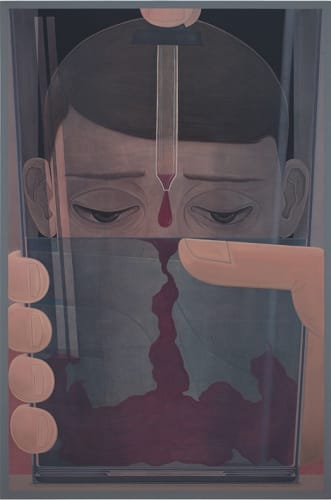Painter Michael Stamm applies thin glazes in multiple layers to create tightly composed surfaces with an almost overwrought quality. When I visited Stamm in his Brooklyn studio, he told me that these layers create an “emotional patina” that heightens the work’s psychological charge. The first painting I saw was B12 (2017), in which an androgynous figure watches through large, heavily lidded eyes as droplets of maroon liquid dissolve in a glass of water. The digits of the hand that grips the glass appear at the edges of the canvas, while two other fingers intrude from above, squeezing an eyedropper. Stamm tends to portray bodies in a highly stylized and often severely cropped manner, directing attention away from physical experience and toward interior life.
Early in 2016, while still pursuing an MFA at New York University, Stamm had his first solo exhibition, at Thierry Goldberg Gallery. Perhaps in an effort to arrest the frenetic pace of production in this period, he began April 26, 2016, a work consisting of nine small panels that depict the same corner of his studio at varying times of day. His recent paintings develop the compositional strategies and sequential concatenation of that ensemble.
Among the works in Stamm’s current exhibition at DC Moore is a group of eight modestly scaled portraits of his therapist, each showing her at a different session.
We don’t see her face in any of the paintings. Our gaze is drawn instead to the patterns on her blouse and her outlandish jewelry, which serve as her primary means of expression.
In addition to the therapy paintings, the show includes seven larger works. In Tincture #2, a figure posed in a headstand is seen through a cloche containing flowers and twigs, which break the body and its surroundings into fractal-like planes. The human figure seems more like a design element here than like an embodied presence. While other young gay painters often trade in erotic imagery, Stamm sublimates the libidinal drive in more cerebral activity, coding quotidian objects with queer history and imbuing them with the status of archetypes. The blood-red liquid and medicine dropper in B12, for instance, could be read as an allusion to the history of HIV/AIDS. With a proliferation of patterns, references, and visual effects, moderated by a uniform surface, Stamm produces paintings that, though restrained, are richly evocative.
